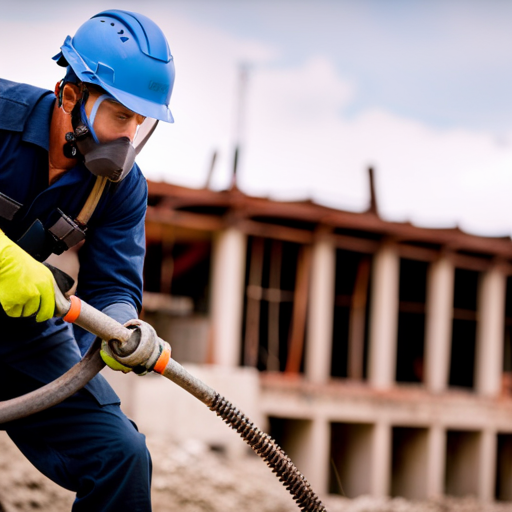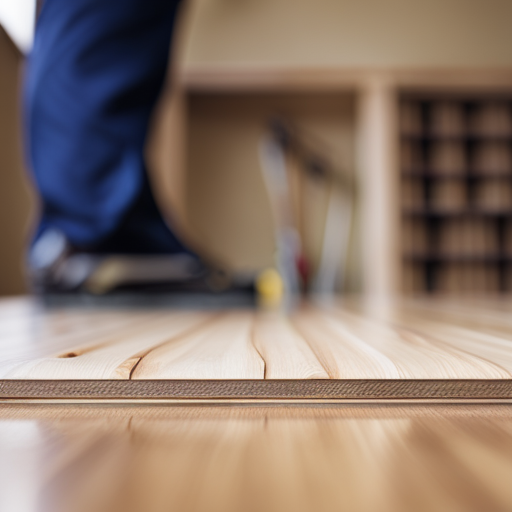
This article aims to provide a comprehensive overview of the process involved in repairing concrete foundation crumbling. The focus will be on assessing the extent of the damage, identifying its causes, and implementing appropriate repair methods.
Detailed instructions will be provided for tasks such as:
- preparing the work area
- removing loose or damaged concrete
- repairing small cracks and surface damage
- reinforcing the foundation with steel or fiber mesh
- applying a bonding agent
- pouring new concrete or using a repair mortar
- curing and sealing the repaired foundation.
This technical guide is intended for an audience seeking safety-related information.
Assessing the Extent of the Damage
To determine the magnitude of the deterioration, a thorough inspection of the concrete foundation should be conducted. Assessing the stability of a crumbling concrete foundation is crucial for ensuring the safety and structural integrity of a building. Evaluating stability involves examining various factors such as cracks, settlement, and moisture infiltration.
One important aspect to consider when assessing the extent of damage is crack width. Hairline cracks are generally not a cause for concern, but wider cracks can indicate significant structural issues. Additionally, the length and direction of cracks should be observed to identify potential areas of weakness.
Settlement or sinking of the foundation can also contribute to its deterioration. This can occur due to poor soil conditions or inadequate construction techniques. Signs of settlement include uneven floors, sloping walls, and sticking doors or windows.
Moisture infiltration is another critical factor in evaluating the damage to concrete foundations. Water seepage through cracks or gaps can weaken the structure over time and lead to further deterioration.
Given these complexities, seeking professional help from experienced engineers or contractors specialized in foundation repairs is highly recommended. Their expertise will ensure accurate evaluation and appropriate repair strategies based on specific circumstances. Safety should always be prioritized when dealing with deteriorating concrete foundations; therefore, professional assistance is essential in determining an effective course of action for repairs.
## Identifying the Causes of Crumbling
One approach to understanding the underlying factors contributing to the degradation of a concrete foundation involves identifying and analyzing potential causes. The causes of deterioration in a concrete foundation can vary, but several common factors have been identified. One major cause is water damage, which can occur due to poor drainage or excessive moisture in the soil surrounding the foundation. This can lead to the corrosion of reinforcement bars within the concrete and result in structural damage. Additionally, exposure to extreme temperature variations can cause expansion and contraction of the concrete, leading to cracks and weakening over time. Other causes include inadequate construction techniques, such as insufficient curing time or improper mixing ratios during construction, as well as natural disasters like earthquakes or floods.
Signs of structural damage in a concrete foundation may include visible cracks on walls or floors, uneven settlement of the structure, doors or windows that are difficult to open or close properly, and gaps between walls and ceilings. It is important for individuals concerned about their safety to be aware of these signs and take appropriate action if they notice any indications of deteriorating foundations.
## Preparing the Work Area
The preparation of the work area for addressing structural damage in a concrete foundation involves several important steps. To ensure safety and efficiency during the repair process, it is crucial to take adequate safety precautions. This includes wearing proper protective gear such as gloves, safety glasses, and a dust mask to protect against potential hazards like chemicals or airborne particles. Additionally, it is essential to establish clear boundaries around the work area using caution tape or barricades to prevent unauthorized access and reduce the risk of accidents.
Cleaning the area is another vital step in preparing the work area. Before any repair work can begin, it is necessary to remove all loose debris and dirt from the damaged section of the foundation. This can be achieved by using a broom or brush to sweep away loose materials, followed by vacuuming or pressure washing if needed. By thoroughly cleaning the area, you ensure better adhesion between new repair materials and existing concrete surfaces.
## Removing Loose or Damaged Concrete
Removing loose or damaged concrete requires careful assessment of the affected area to determine the extent of the deterioration. Before initiating any repair techniques, it is crucial to inspect the concrete foundation for signs of cracking, spalling, or other forms of damage. This assessment will help in identifying the root cause and choosing appropriate repair methods.
To remove loose or damaged concrete, several steps need to be followed. Firstly, all loose pieces must be removed using a chipping hammer or a power grinder with a diamond blade. It is essential to wear protective gear such as safety glasses, gloves, and a dust mask while performing this task. Once the loose material has been eliminated, any remaining debris should be thoroughly cleaned from the surface using compressed air or a wire brush.
Preventive measures play a vital role in ensuring long-lasting repairs. To prevent further deterioration and future problems with the concrete foundation, it is recommended to apply waterproof coatings or sealants after removing loose or damaged concrete. These products create a barrier against moisture penetration and protect the structure from environmental elements.
## Repairing Small Cracks and Surface Damage
Evaluating the extent of small cracks and surface damage is crucial in determining the appropriate course of action for addressing these issues. Repairing hairline cracks and filling small surface depressions are common methods used to restore the integrity of concrete foundations. Hairline cracks, which are typically less than 0.1mm in width, can be repaired using epoxy or polyurethane injections. These materials penetrate the crack and bond with the surrounding concrete, effectively sealing it and preventing further water infiltration.
In cases where there are small surface depressions or spalling, a suitable repair technique involves applying a thin layer of polymer-modified cementitious overlay. This material not only fills the depressions but also provides enhanced durability and resistance to future damage. Before applying any repair solution, it is important to clean the damaged area thoroughly by removing loose debris and preparing a sound substrate for bonding.
To provide a clear overview of different repair methods for small cracks and surface damage in concrete foundations, Table 1 presents a comparison between epoxy injection, polyurethane injection, and polymer-modified cementitious overlay techniques:
| Repair Method | Material | Advantages | Disadvantages |
|:———————-:|:————:|:————————–:|:————————–:|
| Epoxy Injection | Epoxy | Strong bonding strength | Requires professional skill |
| Polyurethane Injection| Polyurethane | Flexible properties | May not be suitable for all cracks |
| Polymer-Modified Overlay| Cementitious | Fills depressions effectively | Longer curing time |
## Patching Larger Holes and Areas of Deterioration
Patching larger holes and areas of deterioration requires the use of specialized materials and techniques that can effectively restore the structural integrity of the damaged surface. When repairing larger holes in a concrete foundation, it is crucial to ensure proper adhesion between the patching material and the existing concrete. This can be achieved by cleaning the hole thoroughly, removing any loose debris or contaminants, and wetting the surface before applying the patching material.
For filling deteriorated areas, it is important to first identify the cause of deterioration. Common causes include water intrusion, freeze-thaw cycles, or chemical exposure. Once identified, appropriate measures should be taken to address these issues before proceeding with repairs.
To fill deteriorated areas, a suitable repair material such as epoxy mortar or polymer-modified cementitious products should be selected. These materials have high strength and durability properties that can withstand harsh environmental conditions.
Before application, it is recommended to prime the area with a bonding agent or apply a thin layer of cement slurry to enhance adhesion. The repair material can then be mixed according to manufacturer instructions and applied using trowels or other suitable tools.
Proper curing should be ensured by following recommended curing procedures for optimal performance and longevity of repairs. It is essential to refer to manufacturer guidelines for specific instructions on mixing ratios, application thicknesses, and curing times.
## Reinforcing the Foundation with Steel or Fiber Mesh
Steel or fiber mesh reinforcement can be used to enhance the structural strength and stability of a deteriorated concrete foundation. These reinforcing techniques are commonly employed in construction projects to prevent further damage and ensure the safety of the structure. Both steel mesh and fiber mesh offer unique benefits that make them suitable for different applications.
Steel mesh is made from high-strength steel wires woven together in a grid pattern. It provides excellent tensile strength, allowing it to distribute loads evenly across the foundation. Steel mesh also offers resistance against cracking and shrinkage, improving the overall durability of the concrete. Additionally, it can withstand high temperatures without losing its structural integrity, making it suitable for use in fire-resistant structures.
On the other hand, fiber mesh consists of synthetic fibers such as polypropylene or glass embedded within the concrete mix. These fibers act as reinforcement by dispersing stress throughout the material, reducing shrinkage cracks and enhancing impact resistance. Fiber mesh is lightweight and easy to handle, making installation more convenient compared to steel mesh.
The following table compares some key characteristics of steel mesh and fiber mesh:
| Characteristic | Steel Mesh | Fiber Mesh |
|————————-|——————————————-|——————————————-|
| Tensile Strength | High | Moderate |
| Fire Resistance | Excellent | Varies depending on fiber type |
| Ease of Installation | Requires professional expertise | Easy |
## Applying a Bonding Agent
The application of a bonding agent is a critical step in reinforcing and stabilizing deteriorated structures. When it comes to repairing concrete foundations, applying a bonding agent offers several benefits and techniques that can enhance the overall safety and durability of the structure.
Some key benefits of using a bonding agent include:
– Improved adhesion: The use of a bonding agent ensures effective adhesion between the existing concrete surface and any repair material applied on top of it. This enhances the bond strength, preventing delamination or separation between layers.
– Increased durability: By promoting better adhesion, the bonding agent helps increase the overall durability and longevity of the repaired area. It minimizes future cracking or spalling, protecting against further deterioration.
– Enhanced structural integrity: The application of a bonding agent provides added structural integrity to the repaired area. It helps distribute loads more effectively across different sections, reducing stress concentrations that could lead to failure.
– Water resistance: Many modern bonding agents also offer water-resistant properties, preventing moisture infiltration into the repaired area. This helps mitigate potential damage caused by freeze-thaw cycles or chemical attacks over time.
When applying a bonding agent, several techniques can be employed:
1. Surface preparation: Properly preparing the concrete surface by removing any loose debris, contaminants, or previous coatings is crucial before applying any bonding agent.
2. Bonding agent selection: Choosing an appropriate type of bonding agent based on specific project requirements is essential for achieving optimal results.
3. Application method: Depending on the chosen product, different application methods such as brush coating or spraying may be recommended to ensure uniform coverage and penetration into pores.
4. Curing time: Following manufacturer instructions regarding curing time is vital to allow sufficient drying and bond formation between layers before proceeding with subsequent repairs.
## Pouring New Concrete or Using a Repair Mortar
Transition: In addition to applying a bonding agent, another effective technique for repairing concrete foundation crumbling is pouring new concrete or using a repair mortar. This method involves the removal of damaged sections and replacing them with fresh concrete or a specialized mortar designed for such repairs.
Current Subtopic: Pouring New Concrete or Using a Repair Mortar
When it comes to repairing concrete foundation crumbling, pouring new concrete or using a repair mortar can be an efficient and cost-effective solution. The decision between these two options depends on factors such as the severity of the damage, budget constraints, and time availability.
Pouring new concrete involves removing the deteriorated sections of the foundation and replacing them with freshly mixed concrete. This technique ensures structural integrity by providing a solid base that can withstand future stresses. However, it requires substantial effort, time, and skilled labor to achieve satisfactory results.
On the other hand, using a repair mortar is often recommended for minor damages or localized areas in need of attention. Repair mortars are specially formulated materials that offer excellent adhesion properties to existing surfaces while providing adequate strength and durability. They come in pre-packaged forms which simplify application and reduce labor costs.
Cost comparison between pouring new concrete and using repair mortars should also be considered. While pouring new concrete may involve higher material costs due to larger quantities required, repair mortars can be more expensive per unit but require less overall material usage.
## Curing and Sealing the Repaired Foundation
Curing and sealing the repaired area is an essential step in maintaining the integrity and longevity of the newly restored section. Proper curing techniques ensure that the concrete gains sufficient strength and durability over time. Here are three important aspects to consider for effective curing and long-term maintenance:
1. Moisture control: Adequate moisture is crucial for proper concrete curing. After repairing the foundation, it is important to keep the repaired area moist by applying a curing compound or covering it with a plastic sheet. This prevents drying out too quickly, which can lead to cracks and reduced strength.
2. Temperature control: Temperature plays a significant role in the curing process. It is recommended to maintain a moderate temperature range between 50°F (10°C) and 90°F (32°C). Extreme temperatures should be avoided as they can affect hydration rates and cause thermal stress.
3. Sealing: Applying a high-quality concrete sealer helps protect the repaired foundation from moisture penetration, chemical exposure, and freeze-thaw damage. The sealer creates a barrier that enhances durability and extends the life of the repair.
## Frequently Asked Questions
### How long does it take for a repaired concrete foundation to fully cure and become structurally stable?
The curing time for a repaired concrete foundation varies depending on factors such as temperature, humidity, and the specific repair method used. Generally, it can take several weeks to months for the foundation to fully cure and achieve structural stability.
### Can I repair a concrete foundation on my own, or should I hire a professional contractor?
When considering DIY concrete foundation repair versus hiring a professional contractor, it is recommended to hire a professional due to the technical nature of the task and safety considerations. Additionally, cost should be taken into account when repairing a concrete foundation.
### Is it possible to prevent future crumbling and deterioration of the concrete foundation after it has been repaired?
Preventing crumbling and deterioration of a concrete foundation can be achieved through proper maintenance and preventive measures. This includes regular inspection, addressing any signs of damage promptly, ensuring proper drainage, controlling moisture levels, and avoiding excessive loads or vibrations on the foundation.
### What are the signs that indicate the need for immediate repair of a concrete foundation?
Signs of concrete foundation damage include cracks in walls or floors, uneven or sagging floors, sticking doors and windows, and gaps around doors or windows. Immediate repair may involve stabilizing the soil, reinforcing the foundation, and filling cracks with epoxy injections.
### Are there any specific safety precautions that need to be taken while repairing a concrete foundation?
Safety precautions are crucial when repairing a concrete foundation. Prioritize personal protective equipment (PPE) such as safety goggles, gloves, and hard hats. Follow repair techniques recommended by experts to minimize risks and ensure a safe working environment.
## Conclusion
In conclusion, it is crucial to address concrete foundation crumbling promptly to prevent further damage and ensure the stability of the structure.
By following a systematic approach that includes assessing the extent of the damage, identifying the causes, preparing the work area, removing loose or damaged concrete, repairing small cracks and surface damage, reinforcing with steel or fiber mesh, applying a bonding agent, pouring new concrete or using repair mortar, and finally curing and sealing the repaired foundation.
Following these steps will help restore the structural integrity of the foundation effectively.



Excellent write-up